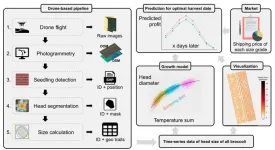(Press-News.org) Australia’s emerging pattern of severe mega bushfires and heavy rainfall may be driving platypuses from their homes, a new study by University of Melbourne researchers has shown.
Analysis of platypus DNA in rivers and creek water samples collected before and after the Black Summer 2019-2020 megafires suggest Australia’s beloved semi-aquatic monotremes might be abandoning severely bushfire-affected areas for up to 18 months after a fire, especially if heavy rainfall has followed the fire.
The study uses the recent technique of environmental DNA sampling, where animal DNA is collected from water, soil, air, or snow rather than directly from the animal itself. This helps scientists indirectly record hard-to-spot animals like the platypus, which are shy, low in number and venture out mostly at night.
The survey, funded by the San Diego Zoo Wildlife Alliance and published today in the journal Biological Conservation, is the first landscape scale study of how platypuses might respond to increases in bushfires and rainfall caused by climate change.
Lead researcher Dr Emily McColl-Gausden, from the Faculty of Science, said the results suggest that a combination of severe bushfire followed by heavy rainfall hit platypus the hardest.
“We simply don’t know how the platypus responds to bushfire. We assume because they are near water, they will be relatively unaffected. While there is more work to do, our research tells us that severe fire followed by intense rain is the worst combination for platypuses,” Dr McColl-Gausden said.
“Fire might not directly kill platypus because their burrows protect them. But when there is rainfall after a fire, as happened in 2019-2020, unstable soil, dead plants and ash and debris can wash into rivers and creeks. This kills the yabbies, aquatic invertebrates and insect larvae that platypus rely on for food and may force them to abandon the site.
“While the platypus may eventually come back, we don’t know the effect of repeated bushfires, whether on their reproduction and life cycle, the survival of their young, on their food security, or on the impact of being forced to move their burrows to more suitable sites. We don’t know if the platypus may one day leave the area for good.”
Researchers repeatedly sampled 118 sites in Victoria and NSW, 57 of which were later affected by the 2019-2020 bushfires. This allowed researchers to have a comparison between fire-affected and non fire-affected sites. They collected samples before the fires, within 6 months after the fires and between 12 and 18 months after the fires, giving them data from three points in time.
Across fire-affected sites, there was a 78 per cent chance a platypus was in an area before the fire, and a 72 per cent chance one year after the fire, before rising again to 79 per cent.
Watersheds are areas of land that drain rainwater into local streams and creeks. When there was heavy rainfall across a site’s watershed and that watershed experienced high severity fire across a quarter or more of its area, the probability that platypus lived at a site fell to less than 10 per cent, indicating that platypus had died or had abandoned the area.
“In Australia, fire helps shape animal and plant distributions. But there is evidence that a new pattern is emerging, where fires are more frequent, bigger, and more severe due to warming and drying trends,” Dr McColl-Gausden said.
Environmental DNA sampling is a useful addition to traditional methods that use humane traps to hold platypus until they can be recorded. While traps give scientists useful data such as age, sex and general health, environmental DNA sampling allows researchers to rapidly monitor large areas of land after a natural disaster like a bushfire.
“Thousands of species of animals live in areas affected by the 2019-2020 mega fires,” Dr McColl-Gausden said.
“Systematic surveys will help us understand how platypus and other native species might be harmed by increases in the number, scale and severity of bushfires, and what governments and the community can do to reduce the cumulative effect of more frequent and more severe bushfires. We need to include this surveillance as part of our normal emergency response.”
END
Extreme fires and heavy rainfall driving platypuses from their homes
2023-10-04
ELSE PRESS RELEASES FROM THIS DATE:
Antigen testing can reduce, but not eliminate, the risk of COVID-19 clusters according to mathematical model
2023-10-04
A research group has created a new model to calculate the probability of the occurrence of localized clusters caused by novel coronavirus infections. Led by Shingo Iwami at Nagoya University with collaborators in the United Kingdom and South Korea model, they revealed that screening of infected persons by antigen testing is effective in significantly reducing the probability of cluster occurrence. However, their findings also suggest that it is not sufficient to prevent clusters caused by highly infectious mutant strains, such as Omicron.
With the availability of COVID-19 vaccines and population immunity, countries around the world are seeking to ...
AI drones to help farmers optimize vegetable yields
2023-10-04
For reasons of food security and economic incentive, farmers continuously seek to maximize their marketable crop yields. As plants grow inconsistently, at the time of harvesting, there will inevitably be variations in quality and size of individual crops. Finding the optimal time to harvest is therefore a priority for farmers. A new approach making heavy use of drones and artificial intelligence demonstrably improves this estimation by carefully and accurately analyzing individual crops to assess their likely growth characteristics.
Some optimistic science fiction stories talk about a post-scarcity future, where human needs are catered for and hard labor ...
Wastewater detects signs of antimicrobial resistance in aged care
2023-10-04
A new study published today, analysing wastewater samples from several aged care and retirement homes in Adelaide, has uncovered worrying signs of antimicrobial resistance (AMR) in at least one facility.
High levels of bacterial resistance against three common antibiotics – ceftazidime, cefepime and ciprofloxacin – were identified in one aged care residential home. A second facility recorded above average levels of antimicrobial resistance to gentamicin, putting residents’ health at risk.
The listed antibiotics are used to treat a variety of bacterial infections, including pneumonia, ...
Unique voice print in parrots
2023-10-04
Parrots are exceptional talkers. They can learn new sounds during their entire lives, amassing an almost unlimited vocal repertoire. At the same time, parrots produce calls so they can be individually recognized by members of their flock—raising the question of how their calls can be very variable while also uniquely identifiable. A study on monk parakeets conducted by the Max Planck Institute of Animal Behavior and Museu de Ciències Naturals de Barcelona might have the answer: individuals have a unique tone of voice, known as a voice print, similar to that in humans. This finding in a wild parrot raises the possibility that a voice print ...
Potential genetic screening for aggressive melanoma
2023-10-04
Researchers from The University of Queensland and The Alfred hospital in Melbourne have identified gene variants which may contribute to people being at higher risk for nodular melanoma.
Dr Mitchell Stark from UQ’s Frazer Institute said nodular melanoma only accounts for around 14 per cent of invasive melanoma cases, but the aggressive subtype is the largest contributor to melanoma deaths.
“Melanoma is highly curable by surgery when diagnosed early, but nodular melanoma is often detected ...
Striking inequalities in provision of life-saving heart valve replacement in England
2023-10-04
Public health initiatives to understand and tackle these inequalities should be prioritised, say the researchers.
The aortic valve keeps blood flowing from the heart's lower left chamber (left ventricle) to the aorta—the main artery bringing blood from the heart to the body. Aortic stenosis occurs when the aortic valve narrows as a result of calcium build-up, impeding normal blood flow. This causes shortness of breath, light headedness, and chest pain (angina).
Aortic valve replacement (AVR) not only relieves these symptoms, but increases life expectancy, and improves quality of life, say the researchers, adding that up to 1 in 4 of those with severe or very severe aortic stenosis ...
Critical data gaps on doctor assisted deaths in Oregon amid rise in participants
2023-10-04
Information on clinical complications is often missing, while key information on the factors behind medical decision-making, the effectiveness of the lethal drugs used, and the extent of palliative care support isn’t even collected, reveals the review.
Physician assisted suicide as it’s formally known has been legal in the US state of Oregon since 1997 under the Death with Dignity Act.
The legislation allows terminally ill residents over the age of 18 to hasten their death by taking lethal drugs prescribed by a doctor, providing they are capable of making and communicating healthcare ...
New robot could help diagnose breast cancer early
2023-10-04
A device has been created that could carry out Clinical Breast Examinations (CBE).
The manipulator, designed by a team at the University of Bristol and based at the Bristol Robotics Laboratory, is able to apply very specific forces over a range similar to forces used by human examiners and can detect lumps using sensor technology at larger depths than before.
This could revolutionise how women monitor their breast health by giving them access to safe electronic CBEs, located in easily accessible places, such as pharmacies and health centres, which provide accurate results.
Precision, repeatability and ...
A prehistoric cosmic airburst preceded the advent of agriculture in the Levant
2023-10-04
Agriculture in Syria started with a bang 12,800 years ago as a fragmented comet slammed into the Earth’s atmosphere. The explosion and subsequent environmental changes forced hunter-gatherers in the prehistoric settlement of Abu Hureyra to adopt agricultural practices to boost their chances for survival.
That’s the assertion made by an international group of scientists in one of four related research papers, all appearing in the journal Science Open: Airbursts and Cratering Impacts. The papers ...
Is universal screening for type 1 diabetes around the corner?
2023-10-04
The the latest data on universal screening for type 1 diabetes (T1D) is reveiwed in a session at this year’s Annual Meeting of the European Association for the Study of Diabetes (EASD) in Hamburg, Germany (2-6 October). The talk will be given by Dr Emily K. Sims, Associate Professor of Pediatrics, Center for Diabetes and Metabolic Diseases, Indiana University School of Medicine, Indianapolis, IN, USA.
Research by various groups has established that individuals with multiple islet autoantibodies (biomarkers showing that the body is attacking and killing its own insulin producing beta cells in ...



